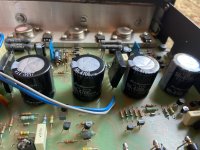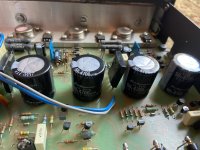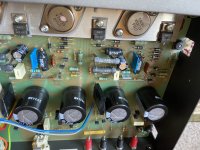Hi everyone,
I recently bought a second hand Quad 306 and have been using it successfully with my Yamaha NS10m’s for about 4-6 weeks.
Sadly, the left output has now started distorting - quite badly, so it’s unusable - and I’m wondering what the best thing to do might be.
I’ve been hearing that it could be that the caps need replacing. Although, the seller - on eBay - said that he’d replaced them recently, but that’s not to say that he’s telling the truth or even if that’s the issue. I’ve also heard that replacing the TR8 (transistor?) could be a possible culprit.
Any suggestions?
Also, if it is the caps, is it something that someone with limited soldering experience can manage? (I’ve changed guitar pickups etc).
Thanks!
James
I recently bought a second hand Quad 306 and have been using it successfully with my Yamaha NS10m’s for about 4-6 weeks.
Sadly, the left output has now started distorting - quite badly, so it’s unusable - and I’m wondering what the best thing to do might be.
I’ve been hearing that it could be that the caps need replacing. Although, the seller - on eBay - said that he’d replaced them recently, but that’s not to say that he’s telling the truth or even if that’s the issue. I’ve also heard that replacing the TR8 (transistor?) could be a possible culprit.
Any suggestions?
Also, if it is the caps, is it something that someone with limited soldering experience can manage? (I’ve changed guitar pickups etc).
Thanks!
James
First thing is to check that the capacitors are the right way round. Then look for any obvious bulging or leakage - I have had capacitors incorrectly marked.
Clear photos would be helpful
Clear photos would be helpful
Here are a few photos.
It was working fine at first so - forgive my ignorance - presumably, that would suggest they were put in correctly.
I'm no expert though, so please let me know if I'm wrong!
It was working fine at first so - forgive my ignorance - presumably, that would suggest they were put in correctly.
I'm no expert though, so please let me know if I'm wrong!
Attachments
Yep, I've gone through all the possible combinations - inputs, outputs, speakers, interface ins and outs etc - and definitively narrowed it down to the left output.
I thought these capcaitor polatitiy looked suspect, but they are correct based on service manual.
you can find it here : https://www.dadaelectronics.eu/uploads/downloads/02_Quad-Service-Manuals/Quad-306-Service-Manual.pdf
Might be worth checking for simple mechanical fault like dry joints?
Is the capacitor on the right touching the power resistor? The heat will kill it very quickly.View attachment 1188334
I thought these capcaitor polatitiy looked suspect, but they are correct based on service manual.
you can find it here : https://www.dadaelectronics.eu/uploads/downloads/02_Quad-Service-Manuals/Quad-306-Service-Manual.pdf
Might be worth checking for simple mechanical fault like dry joints?
The low value brown capacitor in the middle of the photo is folded over - a very strange thing to do
I should be able to!NIce... Could you give us a few pictures of the soldering side? Hope you can easily access it?
Away from my studio at the moment but will be able to post one in a couple days!
From the photos, it doesn't look like anything is touching anything but I'd have to confirm when I'm in front of the unit.
Interesting...
Interesting...
The polarity is OK. If not, they would have exploded by now.. They are 105°C rated and I don't think the heat of the resistors will do much harm since they are elevated from the PCB. Placing them a bit further away would have been better though.I thought these capcaitor polatitiy looked suspect
Start by removing the lower cover and taking a photo with sufficient light.
it makes you think of a power supply or potential reference problem ("0" floating on this amp)
it makes you think of a power supply or potential reference problem ("0" floating on this amp)
We are asking for the solder side.
The fault description sounds like the current dumping is not working.
Do you have a multimeter?
The fault description sounds like the current dumping is not working.
Do you have a multimeter?
oh, I see! Sure, I can take a photo in a couple of days when I'm back in my studio.
Yes, I do have one
Yes, I do have one
Capacitors are rarely the cause for a sudden onset of distortion, that suggests a fried semiconductor or loose connection or failed power rail. You can sometimes get RF oscillations due to aging capacitors, so its possible. In many amps failing electrolytics go unnoticed until the power-on mute and safety circuit starts misbehaving.
Typically we're talking many decades before aging electrolytics become a show-stopper.
First step when working on an amp is be safe, next is looking (sniffing) for any obvious damage/overheating, and then checking the DC power rails are all present at the correct voltage (don't connect expensive speakers to a suspect amp, BTW, some cheap set will do)
Typically we're talking many decades before aging electrolytics become a show-stopper.
First step when working on an amp is be safe, next is looking (sniffing) for any obvious damage/overheating, and then checking the DC power rails are all present at the correct voltage (don't connect expensive speakers to a suspect amp, BTW, some cheap set will do)
Thanks for that, Mark!
To be honest, I think all of this is above my station really. I wouldn't really know what I was looking for with any of this; I think it might be time for me to bite the bullet and get a professional involved.
I was hoping if it was just a very obvious, quick fix, I might be able to do it. Sadly, there is needs to be someone experienced to fully check it over and diagnose it.
Thank you for your help!
To be honest, I think all of this is above my station really. I wouldn't really know what I was looking for with any of this; I think it might be time for me to bite the bullet and get a professional involved.
I was hoping if it was just a very obvious, quick fix, I might be able to do it. Sadly, there is needs to be someone experienced to fully check it over and diagnose it.
Thank you for your help!
- Home
- Amplifiers
- Solid State
- QUAD 306 - Distorted Output: Cap Replacement?




